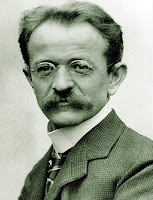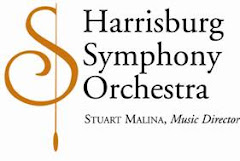Here is a video with Hilary Hahn playing Glazunov's Violin Concerto with Semyon Bychkov conducting the West German Broadcasting Orchestra of Cologne, complete in one clip:
= = = = =
= = = = =
If you're listening to this for the first time, you might think it was a “contemporary” of concertos by Mendelssohn (1845) and Bruch (1866), yet technically it's a 20th Century work, composed in 1904.
 |
| Glazunov, 1899 |
It's true this would have confused conservative music-lovers of the day (and considering what used to annoy people even in Bach and Mozart's days), but for 1904, it was certainly a very old-fashioned “sound-world” considering what was brewing in Paris or Vienna. However, as Peter Sirotin reminded me in our conversation when someone described Glazunov as a “conservative composer” - “great music is not always a matter of innovation.” (That would have been true of Bach if you were comparing him to the music his sons were writing.)
* * ** *** ***** ******* ***** *** ** * *
 |
| Erika Morini |
The simple reason may be that Glazunov is not Tchaikovsky nor does he have the brilliance and tunefulness of Tchaikovsky: the Tchaikovsky Violin Concerto has been performed at least nine or ten times, the Glazunov (as far as I can tell) only once when Erika Morini played it with George King Raudenbush in December of 1935, when, incidentally, Glazunov was still a "living composer."
In fact, all of Glazunov's music heard in Harrisburg before 2004 was conducted by George King Raudenbush, the orchestra's first conductor who retired at the end of the 1949-50 Season: even during the series of “rehearsals” (more like reading sessions) during which the orchestra played through various repertoire before that first public concert in March of 1931, they played “Autumn” and “Winter” from his ballet, The Seasons.
Curiously, Raudenbush programmed Glazunov's 5th Symphony (with its great bear-dance of a finale) twice – in 1943 and again in 1946. But other than his elegant Concert Waltz, Op. 47, so evocative of the great Imperial Age at the end of the 19th Century, also scheduled twice, in 1936 and 1945), nothing else of Glazunov's has been heard in Harrisburg at the symphony.
It is entirely possible, not having access to lists of works performed in the last ten years, something may have been slipped through. I don't recall hearing the concerto but certainly none of the symphonies or tone poems – but then, frankly, they may simply no longer be that interesting to concert audiences because I'm sure Glazunov's ratings, across the US, are probably not that much better than they are here.
Except for the Violin Concerto which is ranked by violinists among the Top 5 or 6 best violin concertos.
Glazunov also survives among saxophonists' repertoires because he wrote the (presumably) first Saxophone Quartet in 1932 and followed it two years later with a Concerto for Alto Saxophone.
Over at Market Square Concerts, Harrisburg had a chance to hear some of his chamber music in recent years, thanks to Peter Sirotin, Artistic Director: the Cypress Quartet played two or three of his Novelettes (and also in Lancaster). The last Summermusic concert of 2013 ended with the String Quintet in A Major.
* * ** *** ***** ******** ***** *** ** * *
When Alexander Glazunov died outside Paris in 1936 at the age of 70, most people were probably shocked: they had no idea he was still alive!
Most would have associated his music so strongly with the previous century and a tradition – as well as a culture – that had disappeared almost 20 years earlier when the 1917 Revolutions swept away the Russian Empire.
While others left – like Stravinsky, Rachmaninoff, eventually Prokofiev (who would later return) – Glazunov who considered himself fairly apolitical stayed behind to re-organize the Conservatory he'd been director of since 1905 when his teacher Rimsky-Korsakov had been forced out of the position (during more political turmoil). He had established a good working relationship with the new Bolshevik regime but found increasing deprivations during the ensuing Civil War and tensions with both faculty and students tiresome. He took advantage of the chance to tour Europe during the Schubert Year in 1928 and ended up staying in Paris. After a visit to the United States, he chose to return to Paris, one of the larger gathering-places for Russian expatriates, where he remained, composing only occasionally, until his death.
Glazunov had the misfortune of being born in that “second generation” of Russian composers between Tchaikovsky and his mentors The Russian Five (with his teacher Rimsky-Korsakov treating him more as a junior associate than a student) and those only slightly younger than himself, Rachmaninoff and Scriabin – and eventually those who were his own students, Prokofiev and Shostakovich.
Among this “lost generation” of composers are Anatol Lyadov, Anton Arensky and Sergei Taneyev, to name just three more who are rarely heard in America. We sometimes reduce a whole era to just two or three famous names – how many average concert-goers could say they've heard many of the contemporaries of Mozart and Haydn or Beethoven and Schubert, covering the years from 1750 to 1828? It would be difficult to name any current Russian composer since Shostakovich died in 1975 who is heard with any comparable frequency in this country.
 |
| Rimsky-Korsakov & Glazunov |
Still in his teens, Glazunov met Franz Liszt who thought highly of his music. His new works began to find their way around the Continent (as Russians and the English referred to the rest of Europe) almost at the same time as his mentors' did, when another supporter, the wealthy music publisher Belyayev, opened a branch in Leipzig.
The young man soon found himself the “junior member” of the Mighty Handful, who, with his prodigious memory, was able to assist his teacher in assembling the disorganized pages of sketches left behind by Alexander Borodin when he died suddenly in 1887, leaving unfinished a third symphony and the massive opera, Prince Igor: the story goes that Glazunov, having heard Borodin play through the Overture at the piano before he'd written anything down, was able to reconstruct it from memory.
One thing that happened was the passing of an era comparable to what Americans recall (for those who admit to remembering it) as “The '60s and '70s” – in this case the 1960s and '70s. In Russia, the 1860s and '70s were a similar kind of age, full of renewed national awareness with political and philosophical agitation among the people. The new Russian tsar, Alexander II, liberated the serfs in 1861 (before Lincoln freed the slaves in our own Civil War) and promised numerous political and social reforms. There were those who, as in earlier centuries, saw Russia as an Asiatic-based heritage (the days of the boyars before Peter I, known in the West as “the Great,” in the late-1600s) inspired by “the people,” particularly through the folk-based music of Rimsky-Korsakov and the “Mighty Handful,” as opposed to the cosmopolitan pro-Western view which continued the aristocratic European-based lifestyle and which we associate with Tchaikovsky.
 |
| Glazunov (by Repin) 1887 |
So the age when Glazunov was at his peak was not the world we associate with his mentors: the pendulum swung quickly and sharply back from the days of the liberal-nationalists. Dostoievsky was dead, and Tolstoy's greatest works had already been published. Even though Rimsky-Korsakov continued to create great works inspired by the Russian folk culture (like his opera, The Golden Cockerel, in reality a political satire), the culture of the times took on that “end-of-the-century” elegance we associate with the imperial ballets of Tchaikovsky. The intellectual life of the 1890s in Russia reminds me, in a way, of American student life after the Viet-Nam War when it seemed there was nothing left to protest. And whatever your political colors may reveal, things in the United States had changed radically from the 1950s into the '60s and '70s and again in the 1980s. Something similar affected Glazunov and his generation as well.
He went from being the promising student of Rimsky-Korsakov in the 1880s to become a successful teacher with an international reputation at the peak of his powers around 1900. But then, with the advent of the political turmoil of 1905 (which momentarily closed down the St. Petersburg Conservatory where he taught and which he would eventually run, once Rimsky-Korsakov had been forced out for being too pro-student) – you might call this the beginning of the long, slow up-beat to the Bolshevik Revolution – Glazunov's world slowly fell apart.
Today, he is perhaps primarily remembered for having ruined Rachmaninoff's 1st Symphony, when he was apparently too drunk to conduct it at its premiere in 1897, whether he understood the piece or not. Glazunov, like Mussorgsky, was one of Russian music's more notorious drinkers: there is the probably true story told by Shostakovich how, in his lessons, Glazunov would sip his booze through a tube hidden in his coat connected to a flask hidden in a desk drawer.
 |
| Shostakovich, Student |
(By the way, you can hear Shostakovich's 1st Symphony at the May Masterworks concert with the Harrisburg Symphony & Stuart Malina.)
In the game of “what if,” one can ask “what if Glazunov didn't have to deal with the chaos that followed the 1917 Revolution?” What if he didn't have to worry about composing because his supply of manuscript paper was about to run out and wouldn't likely be replenished, given the rationings during the Civil War? What if he had left for Paris in 1917 when so many others left their vanishing culture behind? (Leaving Russia didn't help Rachmaninoff much: he hardly ever composed again after he emigrated to the West.) But what would have happened to Shostakovich if Glazunov hadn't been there to mentor him?
So, in many ways, Glazunov's Violin Concerto is a reflection of a soon-to-be-lost age – not just Russia's but also the composer's. Following 1905, most of his energies would be taken up as a teacher and administrator. And with his society in free-fall, what was there for an artist to grab onto to present any kind of artistic vision? He was hardly the man to suddenly start producing proletarian music!
Whatever others might have been able to do, it was not within Glazunov's talent to find an answer, as he himself might probably have been the first to admit. Everything had come easily to him: his “creative crisis” of 1890 was the first sign he was out-growing his role as a prodigy; another one, following 1905, when he was now 40, might have been a mid-life crisis in the best of times. It's not that he stopped composing, but, with few exceptions, he was unable to produce much that was comparable to the quality of what he'd written before.
It is not surprising his last string quartet, written in Paris in 1930, was subtitled “Homage to the Past.”
Dick Strawser

















